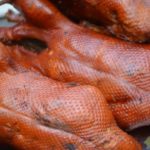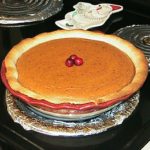By Rich Niccum, Education Services Manager
 As we prepare for the Thanksgiving holiday, I thought I would dispel some of the myths surrounding what we think of as the first Thanksgiving.
As we prepare for the Thanksgiving holiday, I thought I would dispel some of the myths surrounding what we think of as the first Thanksgiving.
In the Fall of 1621 the Pilgrims celebrated their first official harvest and the survival of their fledgling settlement through its first year. They invited the local Wampanoag Native People to a three-day feast of thanksgiving to celebrate and thank them for their help. Over 90 Wampanoag including their leader Chief Massasoit attended the meal. Much food was shared between them during the three-day feast, but it didn’t look anything like our Thanksgiving meal of today. Yes, they had turkey, but it was wild turkey and not today’s large domesticated variety. They most likely ate more duck, other fowl, including Passenger Pigeon which was plentiful and was not unknown for the Pilgrims to shoot over 200 or more at a time form the sky in a single shot. Their meat was roasted not baked in an oven like today. The Pilgrims didn’t have ovens so they wouldn’t have had pies or breads like we have today. Here is a list of what was believed to be on the menu.
- Roasted whole turkey, duck, goose, venison
- Fish and eel covered with leaves and baked in coals
- Shellfish including lobster, clams, mussels, oysters, etc.
- Whole pumpkin, baked in coals and then served with honey
- Two or three other kinds of squash, cut in pieces and cooked in large kettles
- Beans
- Small kettles of peas
- Dried corn boiled in water
- Corn meal, used to make corn bread and other flat iron breads
- Nuts, hickory, acorns, walnuts, and more
- Dried fruit including wild strawberries, raspberries, blueberries, grapes, cherries, cranberries and plums
- Boiled corn meal, sometimes called gruel, served with honey
- Other vegetables – Beets, turnips, onions, garlic, radishes, mustard greens, mushrooms, carrots, wild leeks
 What was not on the menu was potatoes. White potatoes from South America and sweet potatoes from the Caribbean had not made it to North America by this first feast so no mashed potatoes or really potatoes of any kind like we see today. They also didn’t have cranberry sauce, which would be another fifty years in the making. They most likely didn’t have stuffing like we know today though could have stuffed their meat with nut meat and seasonings. Wine was not served during the meal like many might today, but instead most drank good old water. And finally, no pumpkin pie. Again, they didn’t have stoves to bake pies in and they didn’t have flour to bake with.
What was not on the menu was potatoes. White potatoes from South America and sweet potatoes from the Caribbean had not made it to North America by this first feast so no mashed potatoes or really potatoes of any kind like we see today. They also didn’t have cranberry sauce, which would be another fifty years in the making. They most likely didn’t have stuffing like we know today though could have stuffed their meat with nut meat and seasonings. Wine was not served during the meal like many might today, but instead most drank good old water. And finally, no pumpkin pie. Again, they didn’t have stoves to bake pies in and they didn’t have flour to bake with.
 So, while much of the food and the customs were very different then our Thanksgiving celebrations today, the spirit of the meal hasn’t changed. It continues to be a time for friends and family to gather around the table for fellowship and to reflect on what we are thankful for in our lives. So, take some time this Thanksgiving and think about what you are most thankful for in 2019. I also encourage you to take a moment to stop and think about what it may have been like to attend that first harvest celebration in 1621. Happy Thanksgiving from Preservation Parks.
So, while much of the food and the customs were very different then our Thanksgiving celebrations today, the spirit of the meal hasn’t changed. It continues to be a time for friends and family to gather around the table for fellowship and to reflect on what we are thankful for in our lives. So, take some time this Thanksgiving and think about what you are most thankful for in 2019. I also encourage you to take a moment to stop and think about what it may have been like to attend that first harvest celebration in 1621. Happy Thanksgiving from Preservation Parks.






